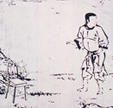Building a Better Bang
U.S. ordnance of all sorts is still killing people in Vietnam, and it will be killing Iraqis for years to come. On September 20, 2006, the United Nations reported that more than 250,000 unexploded cluster bombs — made in the U.S.A. — now litter Lebanon. According to David Shearer, the U.N. humanitarian coordinator in Lebanon, three people per day die from the ordnance.
(http://www.democracynow.org/article.pl?sid=06/09/20/1412233)
Small cluster bombs, such as the BLU-3, project fragments which can maim or kill. But cluster bombs can also be used to deliver chemical weapons.

 Left: BLU-3 cluster bomblet, also called a “Pineapple” bomb, used in Vietnam.
Left: BLU-3 cluster bomblet, also called a “Pineapple” bomb, used in Vietnam.
Right: Cut-a-way view of Honest John warhead holding Sarin bomblets, circa 1960.
Last fall, jouralists from the Italian television station R.A.I. reported U.S. use of white phosphorus during the attack on Falujah in 2004. Now, R.A.I. is reporting accusations that the Israeli military used an experimental weapon against Palestinians in Gaza. The device produces major shrapnel wounds which can maim or kill — and it can cause severe burns.
(http://www.democracynow.org/article.pl?sid=06/10/12/145208)
Apparently, the weapon is similar to a U.S. Dense Inert Metal Explosive, or DIME. The DIME is advertized as a “low collateral damage” weapon because its impact field is relatively small. It is, so to speak, a “precision” cluster bomb. The small impact field, however, is much more intense than that of a typical cluster device. In short, detonated in a crowd, a DIME will wound fewer people than a BLU-3, but the wounds will be much worse. It’s a better bang for the buck. Science marches on.
____________________
(http://www.democracynow.org/article.pl?sid=06/09/20/1412233)
Small cluster bombs, such as the BLU-3, project fragments which can maim or kill. But cluster bombs can also be used to deliver chemical weapons.

 Left: BLU-3 cluster bomblet, also called a “Pineapple” bomb, used in Vietnam.
Left: BLU-3 cluster bomblet, also called a “Pineapple” bomb, used in Vietnam.Right: Cut-a-way view of Honest John warhead holding Sarin bomblets, circa 1960.
Last fall, jouralists from the Italian television station R.A.I. reported U.S. use of white phosphorus during the attack on Falujah in 2004. Now, R.A.I. is reporting accusations that the Israeli military used an experimental weapon against Palestinians in Gaza. The device produces major shrapnel wounds which can maim or kill — and it can cause severe burns.
(http://www.democracynow.org/article.pl?sid=06/10/12/145208)
Apparently, the weapon is similar to a U.S. Dense Inert Metal Explosive, or DIME. The DIME is advertized as a “low collateral damage” weapon because its impact field is relatively small. It is, so to speak, a “precision” cluster bomb. The small impact field, however, is much more intense than that of a typical cluster device. In short, detonated in a crowd, a DIME will wound fewer people than a BLU-3, but the wounds will be much worse. It’s a better bang for the buck. Science marches on.
____________________
Labels: cluster bombs, Iraq, Lebanon, Vietnam


0 Comments:
Post a Comment
<< Home